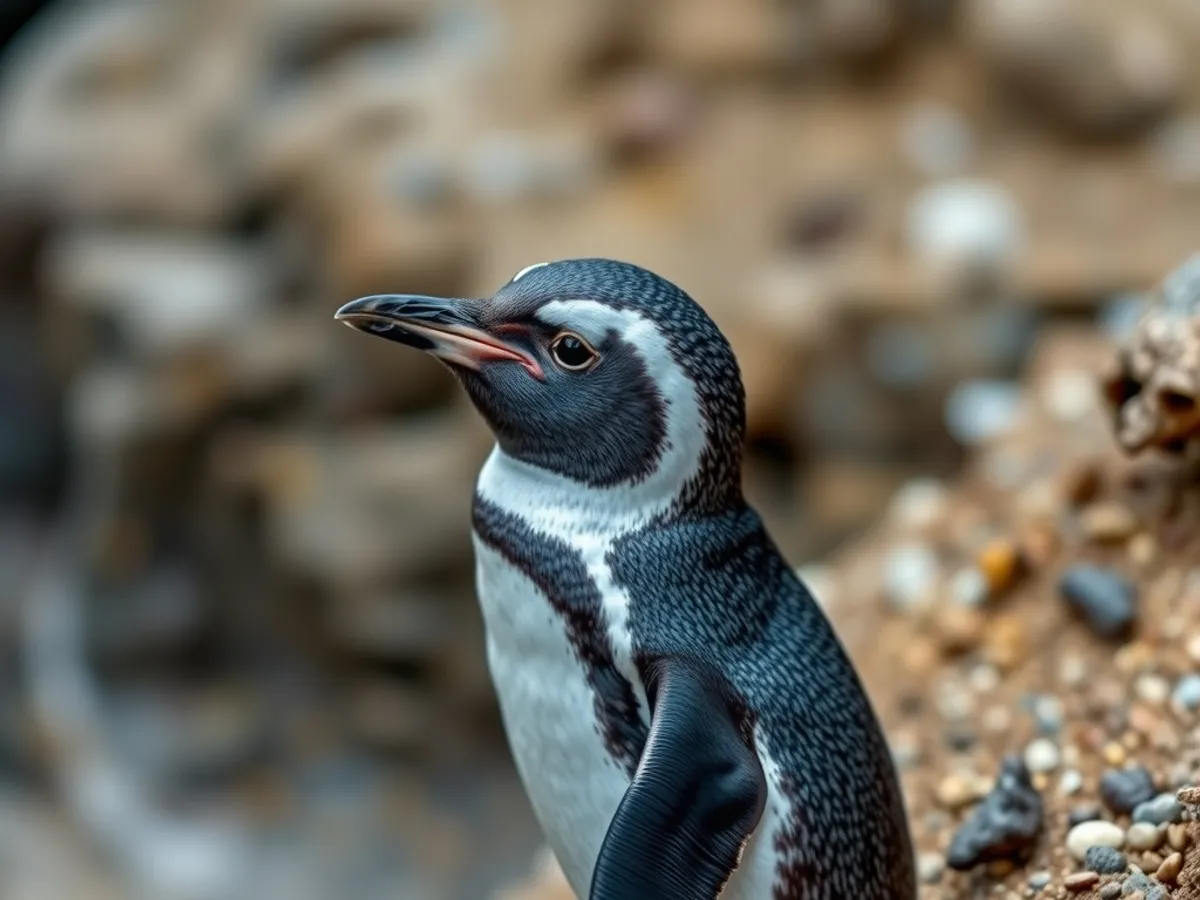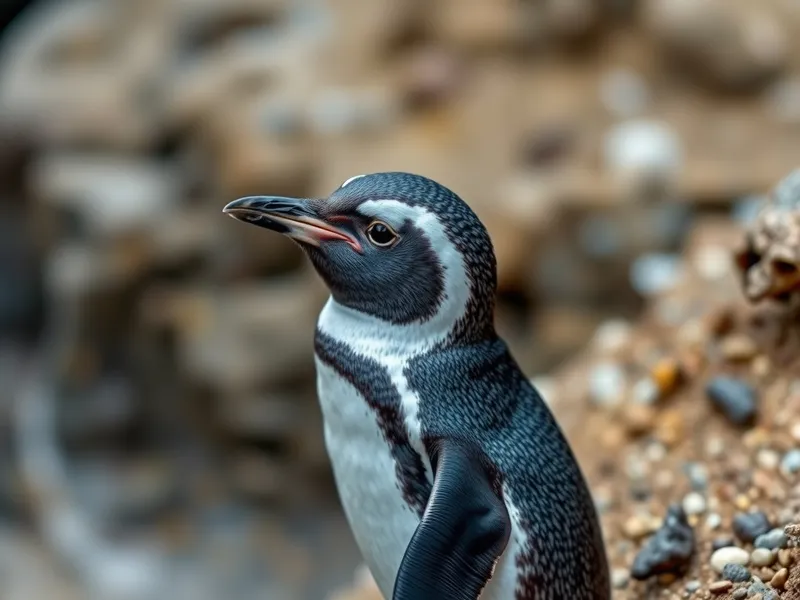
Little Blue Penguin
Eudyptula minor

Meet the Little Blue Penguin
The Little Blue Penguin, also known as the Fairy Penguin, is the smallest species of penguin in the world, standing at just around 30 cm tall. Its plumage is a distinctive slate-blue color, setting it apart from other penguins, which are usually black and white. Native to the coastlines of southern Australia and New Zealand, these penguins nest in burrows, caves, or under vegetation near the shore. They are highly social and often form large breeding colonies, communicating with a range of unique vocalizations.
Classification
Bird
Habitat
Coastal and marine environments
Diet
Carnivore
Lifespan
6-7 years in the wild
Conservation
Least Concern
Weight
0.9–1.2 kg
📖Fascinating Facts
World's Smallest Penguin
The Little Blue Penguin is the tiniest penguin species, typically only 25–33 cm tall.
Nocturnal Land Habits
Unlike most penguins, Little Blue Penguins are active on land mostly at night to evade predators.
Faithful to Home
These penguins are known for their site fidelity, often returning to the same nesting burrow each breeding season.
📋Detailed Description
The Little Blue Penguin (Eudyptula minor) is the smallest extant penguin species, typically measuring 25–33 cm in height and weighing between 0.9–1.3 kg. Its plumage is uniquely slate-blue on the dorsal side and white on the ventral side, providing camouflage both from aerial and underwater predators. The bill is relatively slender and dark, while the feet are pale with black soles and webbing. Adapted for an aquatic lifestyle, its wings have evolved into flipper-like structures, enabling agile and efficient underwater propulsion. On land, Little Blue Penguins exhibit an upright posture and a distinctive waddling gait. Their eyes are adapted for low-light conditions, supporting their nocturnal terrestrial activity. These penguins are highly social, forming dense colonies during the breeding season and engaging in complex vocal communications. They are known for their site fidelity, often returning to the same nesting burrows year after year. Lifespan in the wild typically ranges from 6 to 7 years, though individuals have been recorded living up to 20 years in protected environments.
💡 Did you know?
Little Blue Penguins often return to the exact same nesting site and even the same burrow year after year.
🔬Research & Sources
Wikipedia Summary
The little penguin is the smallest species of penguin. It originates from New Zealand. It is commonly known as the fairy penguin, little blue penguin, or blue penguin, owing to its slate-blue plumage and is also known by its Māori name kororā. It is a marine neritic species that dives for food throughout the day and returns to burrows on the shore at dusk, making it the only nocturnal penguin species on land. The Australian little penguin, from Australia and the Otago region of New Zealand, is considered a separate species.
Last Modified: 6/11/2025
🎭Behavior & Social Structure
Little Blue Penguins are diurnal foragers, spending daylight hours at sea hunting for small fish, squid, and crustaceans, with a preference for species such as anchovies and pilchards. They are pursuit divers, capable of reaching depths of 20–35 meters, though most dives are shallow and last less than a minute. Foraging trips can range from a few kilometers to over 20 km offshore, depending on prey availability. At dusk, they return to land in groups, a behavior known as 'rafting,' to reduce predation risk. On land, they are primarily nocturnal, moving to and from their burrows under the cover of darkness. Socially, they communicate through a repertoire of calls, including braying, growling, and trumpeting, which serve functions from mate attraction to territory defense. Aggressive interactions are common during the breeding season, especially over burrow sites.
👶Reproduction & Life Cycle
Little Blue Penguins are monogamous for at least a single breeding season, with some pairs remaining together for multiple years. Breeding typically occurs from June to December, varying regionally. Nests are constructed in burrows, natural crevices, or under dense vegetation, often lined with grasses and feathers. Females usually lay two eggs per clutch, with both parents sharing incubation duties over a period of 33–37 days. After hatching, chicks are brooded and fed by both parents for approximately 18–38 days, after which they are left alone during the day while parents forage. Fledging occurs at 7–8 weeks, after which juveniles become independent. Breeding success is highly dependent on food availability and predation pressure.
🛡️Adaptations & Survival
Eudyptula minor exhibits several notable adaptations: its small size and streamlined body reduce drag in water, while strong, flipper-like wings enable rapid, agile swimming. The dense, waterproof plumage provides insulation against cold marine environments. Their coloration offers counter-shading camouflage, protecting them from both aerial and aquatic predators. Vision is adapted to low-light conditions, facilitating nocturnal activity on land. Burrowing behavior provides protection from temperature extremes and predators. Social vocalizations and individual vocal signatures aid in mate and chick recognition within crowded colonies. Their flexible diet and foraging strategies allow them to exploit a range of coastal and inshore marine habitats.
📚Research Sources
🎨Cultural Significance
In New Zealand, the Little Blue Penguin, or kororā, holds cultural significance for the Māori, featuring in traditional stories and regarded as a taonga (treasured) species. The penguin is a symbol of coastal identity and is featured in local tourism, conservation campaigns, and community events. Its endearing appearance and nocturnal habits have made it a subject of folklore and children’s literature. In some regions, community-led conservation projects have fostered a sense of stewardship and pride in protecting local penguin colonies.
🔬Recent Research & Discoveries
Recent genetic and morphological studies have clarified the taxonomy of Eudyptula, distinguishing E. minor (New Zealand) from E. novaehollandiae (Australia and Otago, NZ). Ongoing research focuses on foraging ecology using GPS and accelerometer tags, revealing detailed movement patterns and habitat use. Studies on vocal communication have documented individual-specific calls and their role in social organization. Conservation research includes the effectiveness of artificial nest boxes, predator exclusion, and the impact of urbanization on colony health. Long-term monitoring programs are tracking population trends in response to environmental change.
🎥Wildlife Videos

Wildlife - Just Penguins | Free Documentary Nature
Wildlife - Episode 2: Just Penguins | Wildlife Documentary Watch 'Wildlife - Episode 3' here: https://youtu.be/eiqeZwk7NhI This ...
Free Documentary - Nature

Kororā: Little Blue Penguin | Documentary | RNZ
In 2020, a Banks Peninsula family works to protect and survey the Indigenous population of white-flippered penguins, through ...
RNZ

Penguin chicks rescued by unlikely hero | Spy in the Snow - BBC
Spy in the Snow | BBC #SpyintheSnow #bbc.
BBC

Penguins Go MONTHS Without Feeding! | Wild Bites | BBC Earth Kids
Wild Bites is a fun, fact-packed blast of everything you need to know about some of the world's most amazing animals, with ...
BBC Earth Kids

Penguin Central: Full Nature Documentary
Every winter, four penguin species breed in four very different locations in southern New Zealand. Researchers and wildlife ...
Get.factual

Best Penguin Moments | BBC Earth
Living in some of the coldest, harshest conditions on Earth means that every day is a struggle to survive. From facing off against ...
BBC Earth
🌍Habitat Information
The Little Blue Penguin typically inhabits Coastal and marine environments environments. Little Blue Penguins have adapted to their environments with specialized features and behaviors.
Primary Habitat:
Coastal and marine environments
More detailed habitat information will be available soon.
🛡️Conservation Status
The Little Blue Penguin is currently classified as Least Concern. Conservation efforts are crucial for preserving this species for future generations.
Common Threats:
- 🏠Habitat loss and fragmentation
- 🌡️Climate change impacts
- 🎯Hunting and poaching
- 🏭Human-wildlife conflict
⚠️Threats & Conservation Challenges
Despite being classified as Least Concern, Little Blue Penguins face several threats. Introduced terrestrial predators such as dogs, cats, stoats, and rats pose significant risks to eggs, chicks, and adults. Habitat loss due to coastal development, human disturbance, and erosion reduces available nesting sites. Oil spills, marine pollution, and entanglement in fishing gear threaten foraging adults. Climate change impacts, including sea level rise and shifts in prey distribution, may affect breeding success and population stability. Some local populations have experienced declines, prompting targeted conservation actions such as predator control, habitat restoration, and public education.
🔬Scientific Classification
Scientific Name
Eudyptula minor
Classification Hierarchy
🔍 About Taxonomic Classification
Taxonomic classification is a hierarchical system used by scientists to classify and organize living organisms based on shared characteristics and evolutionary relationships.
The system moves from broad categories (Kingdom) to increasingly specific ones, with each animal's scientific name typically consisting of its Genus and species.
📝Community Notes
Share your observations and insights about the Little Blue Penguin with our community of wildlife enthusiasts.
Join Our Community
Sign in to share your observations and connect with fellow wildlife enthusiasts.
Sign In to ContributeNo community notes yet
Be the first to share your observations about the Little Blue Penguin!
Explore Little Blue Penguin
Select a tab above to learn more about this amazing animal.
📸Photo Gallery
No photos available for this animal yet.
🌟Discover More Wildlife
Continue your journey of discovery with more fascinating animals from our database
